
© Simon Annand. (Click image for larger version)
Matthew Bourne’s Sleeping Beauty: a Gothic Fairy Tale
Matthew Bourne
Sleeping Beauty
London, Sadler’s Wells
7 December 2012
www.new-adventures.net
www.sadlerswells.com
It’s taken Matthew Bourne 17 years to complete his Tchaikovsky ballet trilogy, in time to celebrate his company’s 25th anniversary. He started with his Nutcracker in 1992, followed by his masterpiece, Swan Lake, in 1995. The Sleeping Beauty has perhaps the best music and least promising plot of the three Imperial era ballets: a considerable challenge for Bourne, who wisely bided his time before tackling it.
In the 1890 scenario, the royal heroine misses much of the plot development by being either in her cradle or unconscious; she marries a man after the briefest introduction by a fairy, without having come to terms with a changed world a century later. The chosen prince has done little to deserve her, other than break a curse with a kiss. The bad fairy who laid the curse conveniently evaporates without a struggle. The newly-wed time-travel pair live happily ever after.
The ballet survives as a gold standard test of a company’s prowess because of its music and choreography. Aurora has to interest audiences in who she is by the way she accomplishes Petipa’s steps as she grows to maturity. She is framed by a panoply of courtiers, merry peasants, girlfriends, suitors, fairy godmothers, nymphs and fairytale characters, all dancing their hearts out. Tchaikovsky is meanwhile telling of a battle between good and evil, harmony and disorder, holding out the assurance that love will triumph in the end.
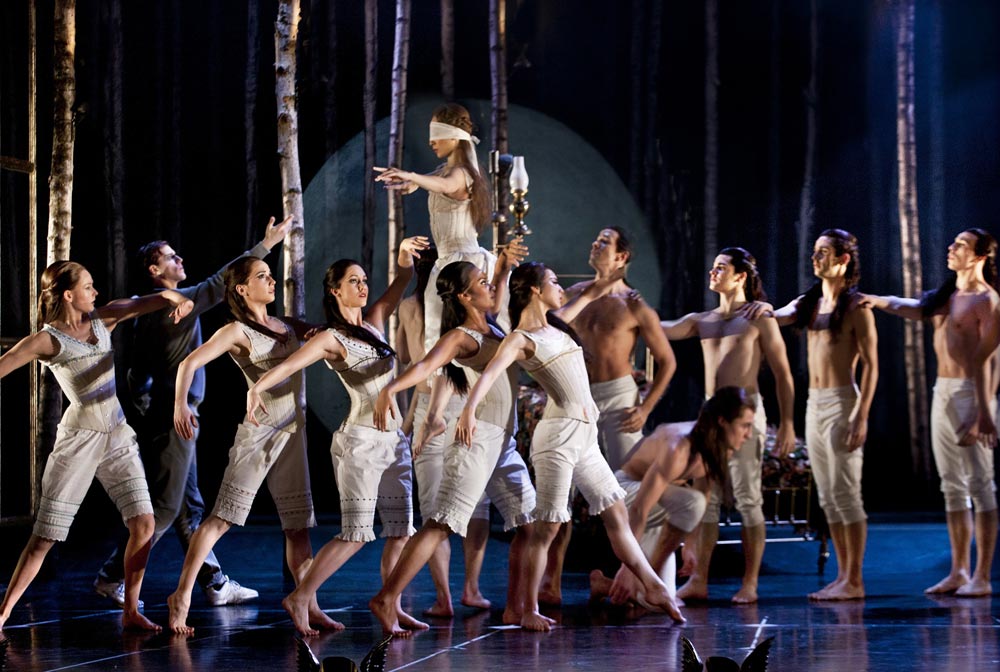
© Simon Annand. (Click image for larger version)
In Bourne’s re-imagined gothic version, just who is Aurora? His prologue starts in 1890, with a dodgy adoption procedure. A royal couple who long for a child are presented with a baby by Carabosse, a dark fairy: no questions asked, no thanks given. The baby, a well-rehearsed puppet, is pretty fiendish with its courtier minders, though its proud parents dote on it. If this were a Bournonville ballet, we’d recognise the child as a troll from the underworld.
Come the full moon, supernatural beings arrive to honour the (very alert) foundling ‘princess’. The fairy revels are interrupted by Carabosse (Ben Bunce), a towering harridan in scarlet with two feral escorts. She/he is outraged at the royal couple’s lack of gratitude – a stronger motive for a curse than not being invited to a christening. The curse is a chilling one, enacted by masked figures. Aurora will blossom only to suffer a terrible fate: death or worse. The fairies’ leader, Count Lilac, offers an antidote in the form of a boy saviour. The story-telling is clear, but it can’t match the grandeur of the music’s promise that eventually all will be well.

© Simon Annand. (Click image for larger version)
The problem for a ballet-lover is that Bourne’s choreography for the prologue is ballet-lite, referring to Petipa’s enchaînement for the fairies without hard-won classical accuracy. The movement doesn’t radiate from a secure centre, feet aren’t precisely placed and the garble of steps doesn’t illuminate the music. The disequilibrium is the more disturbing because Christopher Marney as Count Lilac strikes well-trained balletic positions, whereas Joe Walkling as the Fairy of Plenty buzzes about like a drunken insect, and Liam Mower as the Fairy of Temperament dances a frantic parody of the ‘finger’ variation. Better to have avoided the Petipa references altogether since these fey creatures aren’t giving Aurora aristocratic attributes as christening presents.
We meet the real girl (Hannah Vassallo on the press night) in 1911, when she’s 21 and celebrating her coming-of-age in the grounds of her adoptive parents’ castle. Lez Brotherston provides a miniature Downton Abbey in the background and a stone weeping angel in the foreground – a harbinger of the curse to come. Aurora is a wild wench, prancing barefoot among decorous Edwardian tennis players. In a twist on Giselle’s situation, she is attracted to the game-keeper, Leo (Dominic North), rather than her lordly suitors. She finds a way to be with Leo by the rose bed, hurling herself into his arms with unballetic abandon. But she can’t escape for long from the clutches of a mystery guest who resembles a cross between Gary Glitter and Count Dracula. He (Ben Bunce) is Caradoc, Carabosse’s son, whose predatory advances go weirdly unnoticed by the other guests.
He drugs or poisons Aurora with a black rose, fulfilling his late mother’s threat. (So bad fairies aren’t immortal?) Count Lilac intervenes, transforming the unconscious girl into a zombie behind the locked palace gates. Helpfully, he sinks his fairy fangs into horrified Leo’s neck, thereby ensuring he’ll be able to join the undead in the second half. He’s got to last at least another hundred years.

© Simon Annand. (Click image for larger version)
After the interval, we’re up to date – or rather, 2011. Modern youths record the overgrown palace gates on their mobile phones and leave before Count Lilac leads blindfolded Leo into the Twilight zone. So Leo is Orpheus in search of Eurydice as well as being a vampire; his Lilac guide carries a red rose like the French aristocrat in the Powell and Pressburger film, A Matter of Life and Death. The rose is a rare touch of colour in a wintry monochrome forest. This after-life vision scene works well on its own terms, with sleepy zombies nodding along to Tchaikovsky’s pulsing rhythms for woodland naiads.
Puzzlingly, it seems that Caradoc can’t consummate his evil way with comatose Aurora until Leo awakens her with a vampire’s kiss. He fights the forces of evil but can’t yet win, which adds dramatic tension to the final act. Caradoc proceeds to conduct a satanic ritual in a nightclub, the Gothic celebrants elaborately dressed in red. Aurora emerges as a sacrificial bride in white to the lovely violin entr’acte music. The wedding mazurka, played at speed, whips the vampires (if that’s what they are) into a frenzy. In a coup de théâtre, Caradoc is made the cult’s victim as Leo rescues Aurora.
They dance ecstatically together: Tchaikovsky blesses their tumbling union, a justifiable alternative to the dynastic formality of Petipa’s grand pas de deux choreography. Then comes a delightfully surprising apotheosis. The heroic couple are ushered to their marriage bed, from which a magical baby emerges. It can’t be a royal heir: there’s no blue blood in its veins. But it has wings, so, like its parents, it’s bound to live for ever – happily, we trust.
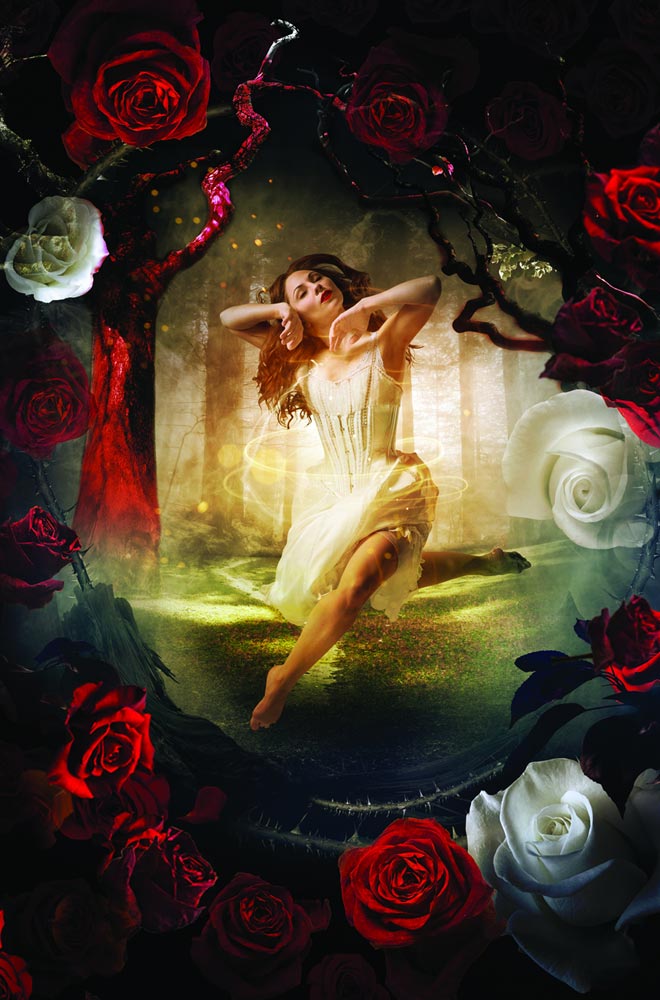
© Hugo Glendinning. (Click image for larger version)
Bourne and Brotherston create a captivating theatrical world in which unpredictable things can happen even in a familiar story. There’s nothing sacred or saccharine about this Sleeping Beauty. In fact, the setting is so noir that it’s hard to distinguish between good fairies and damned ones, especially since immortals of all kinds sport wings and smudged eye sockets. The opening and closing revelry, though over a hundred years apart, share much the same Victorian aesthetic, framed by a proscenium arch with jet and gold pillars and bronzed footlights with wings. Only the Edwardian act is light and bright, as Aurora kicks up her heels and defies her privileged upbringing by choosing a lowly love – a foretaste of how the world will indeed have changed a century later.
My (inevitable) reservations are about the taped music, recorded to suit the production’s dramatic requirements under the baton of Brett Morris; and the variable choreography, which vacillates uneasily between ballet and dance-theatre. But I’m well aware that Bourne’s priority, one that non-specialist audiences really appreciate, is theatrical truth and entertainment. He knows he can’t surpass Petipa – or Ivanov for Swan Lake – but he can tweak their scenarios into something uniquely his own. And he’s magnificently served by a cast of just 17, capable of switching roles at the twitch of a fairy’s wing.












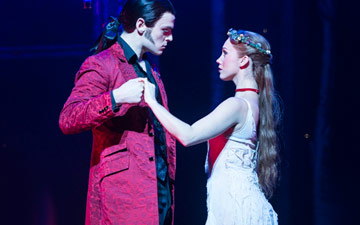
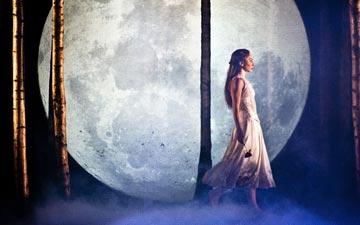

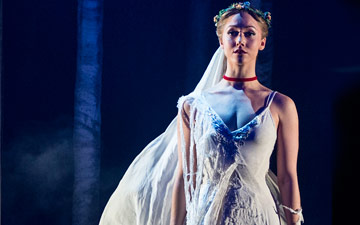
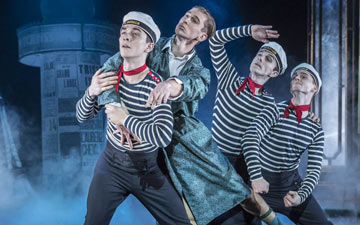
You must be logged in to post a comment.